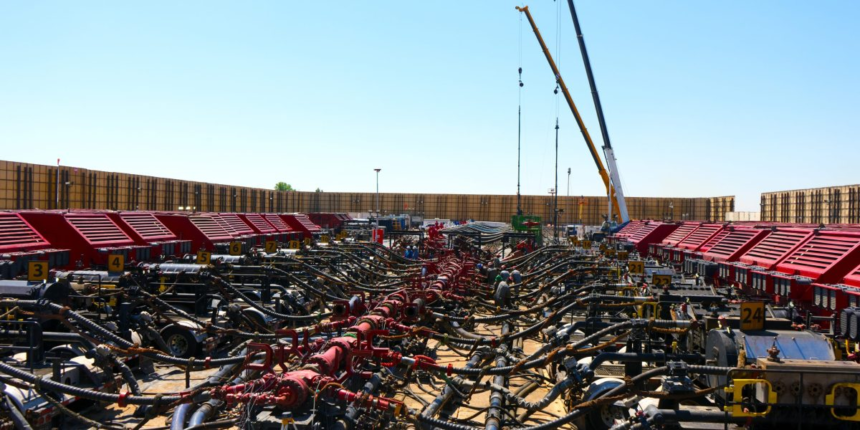Oil prices are their lowest since the pandemic, revenues are falling, and profits are shrinking, but some frackers and oilfield players are suddenly thriving in the stock market as they invest in power generation for data centers and ride the AI wave.
The AI power push from some drillers and fracking companies comes as they face the double whammy of weak oil prices and years of declining activity because of increased efficiency from drilling rigs and hydraulic fracturing, or frac, fleets.
Tom Curran, energy technology analyst with Seaport Research Partners, told Fortune the power opportunity is an emerging bright spot in an industry suffering through a slump.
“It’s very real, it’s early, and it’s to be determined which sort of approaches and types of contracts prove to be the most competitive,” Curran said. “Investors are still ascending the learning curve and trying to get comfortable with the risk-reward profiles of this new niche that’s arisen.”
Somewhat surprisingly, the biggest complaint of Liberty Energy CEO Ron Gusek was directed at the boss of his former boss—President Trump—especially on the steel and aluminum needed for power equipment.
“Is this a path to winning a race the administration has identified as so critical to our nation’s future? I would argue, no. It’s a path to mediocrity at best. I hope we quickly pivot to a different course, one that puts us firmly on the path to energy and AI dominance here in the U.S.”
Liberty Energy had already invested substantially in natural gas generator equipment to electrify and power its fracking services in the oilfield, and now it’s adapting the digipower technology for data centers. Fortunately, the timing fits well with the overall industry trend of electrifying the oilfield and transitioning away from dirtier diesel power.
Liberty is increasing its power generation capacity from a planned 400 megawatts to more than 1 gigawatt—enough to power about 750,000 homes—through 2027. Further increases are anticipated to meet the growing demand, Gusek said.
“My expectation is we probably end up with a higher percentage of our capacity with data center customers than maybe we had anticipated at the outset of our foray into this business,” he said. “We are confident in the growth trajectory of our power business and are expanding our power deliveries in anticipation of customer conversions from our expansive pipeline of opportunities.”
Whether the on-site power is a short- or long-term solution for hyperscalers, Liberty has an answer. Liberty also partnered with nuclear power startup Oklo for companies to transition to Oklo’s small modular nuclear reactors in five years, once they’re ready to come online.
Halliburton, with its larger global footprint, including in the oil-dependent and tech-hungry Middle East, aims to take its power partnership worldwide on a “global industrial scale,” as CEO Miller described it on a recent call with analysts.
Other oilfield players, such as Baker Hughes, SLB, and Solaris, are focused on increasing gas turbine manufacturing for data centers. Solaris is working with xAI at its Memphis complex. SLB is growing its “data center solutions” business focused on cooling systems and other critical hardware.
The key to long-term success, Seaport Research’s Curran said, is not just speed but consistency.
“It’s one thing to go out and put together the capex and plow it into building a fleet of these assets and deliver them, set them up, and turn them on; it’s another thing to meet the standards of 24/7 power reliability,” Curran said.
While the power opportunities are bright, the current earnings reports are much more dour as the oil sector slogs along with weakened activity.
Liberty posted third-quarter net income of $43 million, down 42% year on year, while quarterly revenues fell 17%.
Likewise, Halliburton’s net income plunged down to a barely profitable $18 million—including hefty impairment charges—from $571 million, although revenues only fell 2%.
“Oil and gas industry frac activity has now fallen below levels required to sustain North American oil production,” Gusek said. “Oil producers, which comprise a vast majority of North American frac activity, opted to moderate completions against the backdrop of macroeconomic uncertainty and after exceeding production targets during the first half of the year.”
The companies are lowering their 2026 capex plans, retiring equipment, cutting jobs, and doing as much belt tightening as they can.
There is growing optimism that the global oil glut—exacerbated by ongoing OPEC production hikes—will peak in the first half of 2026, allowing for the industry to rebound in the back half of next year, CEOs said.
Curran sees that sentiment as bullish, even if it means several more months of a downturn.
“We’re finally reaching the end of what has been this long, remarkable, continued increase in U.S. oil production while we’ve had an ongoing contraction in U.S. oilfield activity,” Curran said. “That’s been because of this really miraculous continued upturn in productivity. Well, that finally seems to be reaching its end. That means, even if they want to hold oil production flat, they’re going to have to start picking up activity next year.”









